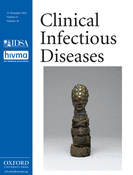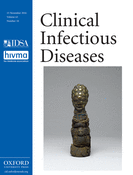
Cover image

Volume 63, Issue 10, 15 November 2016
NEWS
15 November News
IN THE LITERATURE
In the Literature
ARTICLES AND COMMENTARIES
Antibiotic Use in Small Community Hospitals
Antibiotic use rates and selection patterns in 15 small hospitals in Utah and Idaho. Prescribing rates and broad-spectrum use vary considerably, and similar to findings in large hospitals. Small hospitals need to become a focus of stewardship efforts.
Substantial Decline in Vaccine-Type Human Papillomavirus (HPV) Among Vaccinated Young Women During the First 8 Years After HPV Vaccine Introduction in a Community
During the first 8 years after human papillomavirus (HPV) vaccine introduction in a community, vaccine-type HPV prevalence decreased >90% in vaccinated young women, demonstrating high vaccine effectiveness, and decreased >30% in unvaccinated young women, providing evidence of herd protection.
Clinical and Virological Characteristics of Ebola Virus Disease Patients Treated With Favipiravir (T-705)—Sierra Leone, 2014
We provide evidence of improved clinical symptoms, reduced viral loads, and prolonged survival time of patients with confirmed Ebola virus disease treated with favipiravir through a retrospective clinical case study.
Editorial Commentary: Considerations of Favipiravir as a Medical Countermeasure in Future Randomized Controlled Trials Against Ebola Virus Disease
Effect of a Dengue Clinical Case Management Course on Physician Practices in Puerto Rico
A 4-hour classroom course on dengue, emphasizing case studies and practical aspects of clinical management, was effective in changing key physician practices in the management of patients hospitalized with dengue in Puerto Rico.
Case-Control Study of Vaccine Effectiveness in Preventing Laboratory-Confirmed Influenza Hospitalizations in Older Adults, United States, 2010–2011
Our case-control study findings suggest that, during 2010–2011, seasonal influenza vaccination reduced the risk of influenza-associated hospitalizations by >50% among adults aged ≥50 years. Even in those aged ≥75 years, vaccination was significantly effective in preventing influenza hospitalizations.
Detection of Circulating Mucorales DNA in Critically Ill Burn Patients: Preliminary Report of a Screening Strategy for Early Diagnosis and Treatment
Invasive wound mucormycosis is associated with poor prognosis in burn patients. The detection of circulating Mucorales DNA reduces the time to diagnosis by 11 (4.5–15) days relative to standard techniques allowing earlier initiation of treatment and a better outcome.
Editorial Commentary: Toward New Tools to Assess Rare Invasive Fungal Diseases in Critically Ill Patients
Sofosbuvir and Ledipasvir for 8 Weeks for the Treatment of Chronic Hepatitis C Virus (HCV) Infection in HCV-Monoinfected and HIV-HCV–Coinfected Individuals: Results From the German Hepatitis C Cohort (GECCO-01)
New treatment options are available for chronic hepatitis C virus (HCV) infection. Our findings show that 8-week sofosbuvir-ledipasvir treatment is safe and effective under real-world conditions; well-selected patients with HCV and human immunodeficiency virus coinfection respond equally well.
Rectal Infection With Neisseria gonorrhoeae and Chlamydia trachomatis in Men in the United States
Our finding that 17.1% of rectal specimens were positive for Neisseria gonorrhoeae (GC), Chlamydia trachomatis (CT), or both infections suggests that routine testing and timely repeat rectal GC and CT testing should be prioritized among male patients who report receptive rectal sex.
VIEWPOINTS
Individualized Approaches Are Needed for Optimized Blood Cultures
Laboratories should individually optimize procedures for blood culture (BC) collection, processing, analysis, and result reporting. Implementation of rapid BC diagnostics should be done with clinical decision support systems that maximize clinical benefits.
REVIEWARTICLES
Galactomannan, β-D-Glucan, and Polymerase Chain Reaction–Based Assays for the Diagnosis of Invasive Fungal Disease in Pediatric Cancer and Hematopoietic Stem Cell Transplantation: A Systematic Review and Meta-Analysis
Galactomannan, β-D-glucan, and polymerase chain reaction–based assays to detect invasive fungal disease in pediatric cancer or hematopoietic stem cell transplantation demonstrated high negative predictive values for galactomannan, but variable and generally poor sensitivity, specificity, and positive predictive values for all biomarkers overall.
BRIEF REPORTS
Evidence for Human Adaptation and Foodborne Transmission of Livestock-Associated Methicillin-Resistant Staphylococcus aureus
Resurgence of Ebola Virus Disease in Guinea Linked to a Survivor With Virus Persistence in Seminal Fluid for More Than 500 Days
Macracanthorhynchus ingens Infection in an 18-Month-Old Child in Florida: A Case Report and Review of Acanthocephaliasis in Humans
PHOTO QUIZ
A Painful Leg Lump
INVITED ARTICLES
MEDICAL MICROBIOLOGY
Multiplexed Molecular Diagnostics for Respiratory, Gastrointestinal, and Central Nervous System Infections
Multiplex molecular diagnostic panels represent a paradigm shift for both clinical microbiology and infectious diseases. This review summarizes the advantages and limitations of current US Food and Drug Administration–approved tests for respiratory viruses, diarrheal illness, and meningitis/encephalitis.
HIV/AIDS
Should Providers Discuss Breastfeeding With Women Living With HIV in High-Income Countries? An Ethical Analysis
In high-income countries providers are ethically justified in discussing breastfeeding as a reasonable, though inferior, option for mothers living with HIV, as the duty of nonmaleficence must be weighed against the providers' obligation to respect patient autonomy.
Changing Incidence and Risk Factors for Kaposi Sarcoma by Time Since Starting Antiretroviral Therapy: Collaborative Analysis of 21 European Cohort Studies
Early after starting combination antiretroviral therapy, low CD4 cell count is the dominant risk factor for developing Kaposi sarcoma. Detectable human immunodeficiency virus RNA viral load becomes an increasingly important risk factor several years after treatment start, independently of immunodeficiency.
Cognitive Function in Young Persons With and Without Perinatal HIV in the AALPHI Cohort in England: Role of Non–HIV-Related Factors
In young persons with and without perinatal human immunodeficiency virus in England, cognitive impairment was relatively mild, but scores were lower than general population data. Centers for Disease Control and Prevention stage C, worse depression, and black African ethnicity predicted lower scores.



